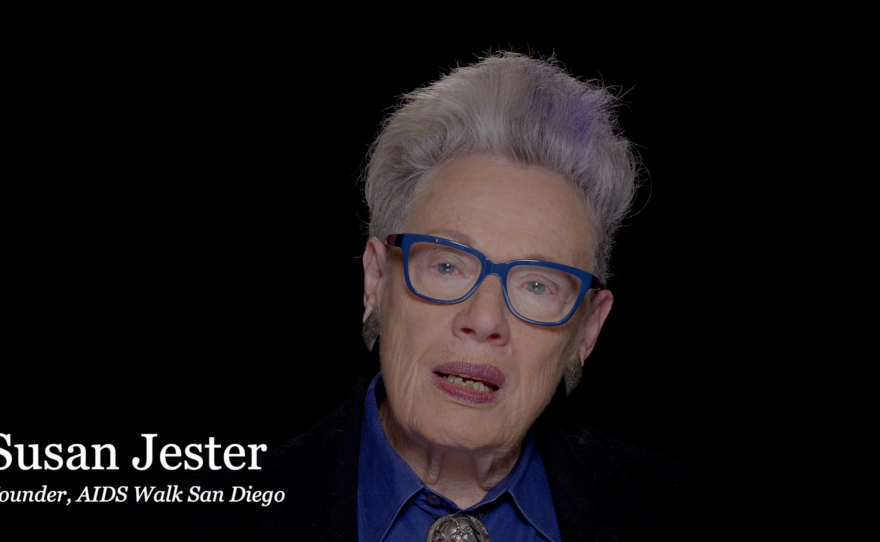Filmmaker Jonathan Hammond did not set out to release a pandemic documentary during a pandemic. What began as a quick gig — making a short video for Elfin Forest-based Fraternity House to use for grant purposes — Hammond's new KPBS Explore Project film, "Expect a Miracle," quickly grew. The documentary is a patchwork of stories about Fraternity House's long history as a hospice house for people dying of AIDS, and also a chronicle of the AIDS crisis in San Diego in the early 1980s.
Throughout the film, a host of prominent local activists, politicians, journalists and more share their stories about the insularity of the gay community in San Diego, and of the sudden change as the AIDS pandemic took hold.
"People started to get sick and die around us, and quickly," said Susan Jester, the first openly gay San Diego City Commissioner and founder of San Diego AIDS Walk.

With the stigma and oppression associated with HIV and AIDS in the 1980s, and a diagnosis forcing people out of the closet, many patients were left to fight the disease alone. For some, Fraternity House was their only chance to die with dignity, as it was the only local institution to treat AIDS patients at the end of life.
"Most of the people had been rejected by their family," said Caroline Thiess-Aird, activist and former Fraternity House board chair. She said that many people died within days or weeks of arriving, but she found joy and hope in being able to provide support in those times. "It was especially beautiful to see people who'd been rejected become part of a healthy family that loved them," Thiess-Aird said.
While Hammond initially interviewed activists and public figures to provide a brief context and history for Fraternity House's story, he was blown away by the stories of people who'd lived through the period locally.
"Their interviews were so compelling, so moving. They were so hungry to tell not just their story but what happened to their community," said Hammond, who ultimately let those stories take up more space in the film. "It became something else. It became like a dual narrative."

Hammond's own experience of the 1980s AIDS crisis seemed far removed from what the San Diego gay community experienced. Raised as a "midwestern Christian boy," in Decatur, Illinois, he was closeted until he moved to California when he was older. And the importance and the impact of those who fought through the crisis is not lost on him.
"Part of why I wanted to tell this story was to give props to the generation before, because they literally had to die out to save the next generation. Like, I am alive because all those people died. And because all those people got sick and died, the ones around them moved mountains to have a treatment," Hammond said.
These mountains, he said, were things like a repressive government, fear, illness and societal intolerance. "Even in media, I remember as a kid, the only time you could see gay people was as a punchline, as a joke, or they died of AIDS. So you had to change hearts and minds."
Hammond sees this story as a love letter to that generation of fighters, but also as an archival ray of hope for young activists. "You have to know history, so we don't repeat it obviously, but also: What did people do to organize to get through whatever the thing is they had to get through?" he said.
"The gay rights movement, where we are now, is a direct result of AIDS. It caused people to speak up. It caused people to come out. Homophobia and the lack of care for AIDS were what pushed a lot of people to come out and to try to change policy — you can only do that if you’re visible. But yeah, there was definitely a boiling point," Hammond said. "If it's a question of survival or quality of life or human decency or basic civil rights, it will cause a boiling point."

Fraternity House's role has grown as the now-treatable disease's impact transformed. Today, the nonprofit — now multiple locations and some semi-assisted living units — serves clients with diverse needs and often multiple diagnoses: HIV and dementia, or HIV and behavioral issues or HIV and homelessness, for example.
The hour-long documentary is more than a powerful look at the history of the AIDS pandemic in San Diego; it's also hope for new generations fighting adversity. "Miracles do happen," said Susan Jester. "But they don't happen unless people take action."
"Expect A Miracle" airs tonight at 9 p.m. on KPBS, Thursday at 9 p.m. on KPBS-2, and streams on the PBS video app.







